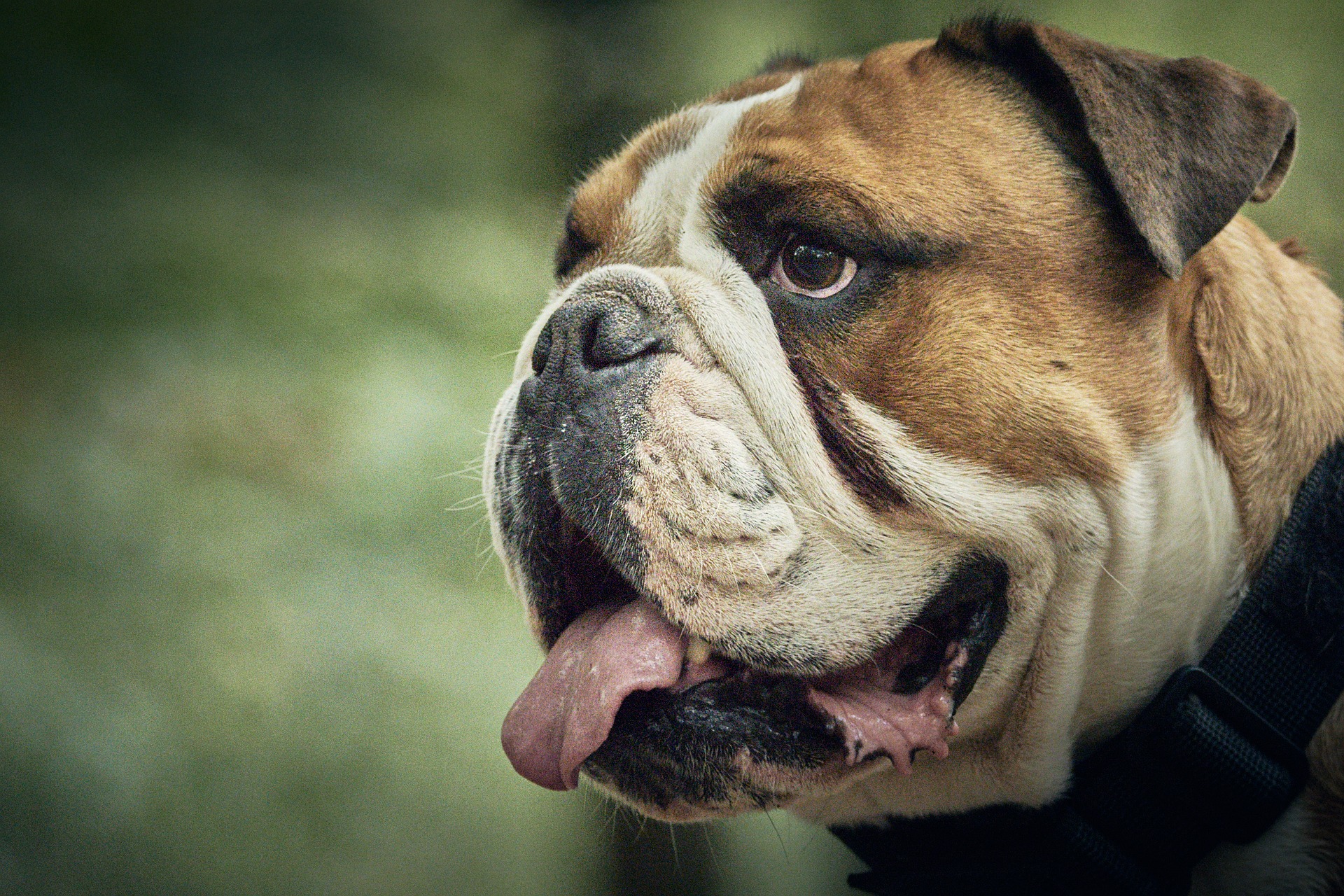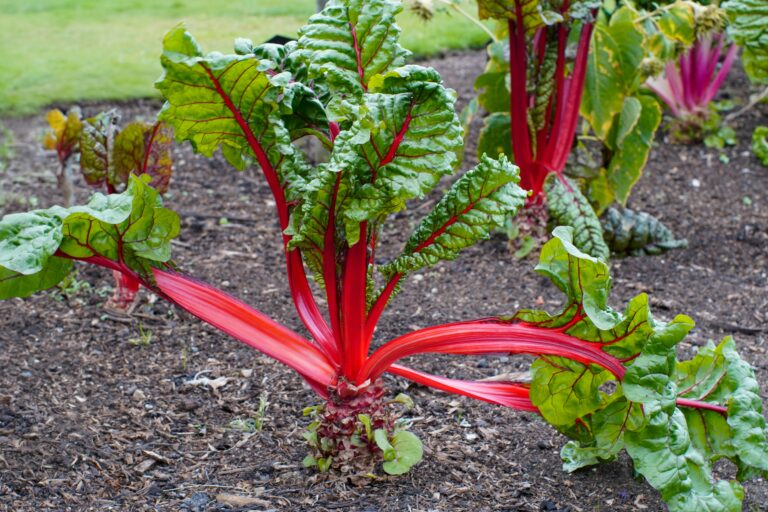If you’ve got rhubarb growing in your garden (which we have here at Planet Bulldog,) then there are a few things you should definitely know. Are rhubarb leaves dangerous to bulldogs? How about rhubarb stalks? It’s time for us to find out, so you can properly protect your pampered pooch.
Are you ready?
Is rhubarb dangerous to bulldogs?
Yes, rhubarb is dangerous to bulldogs.
Every part of the rhubarb plant is dangerous to bulldogs and other dogs. This means the leaves, stalks and roots are potentially toxic to your bully, and you should make sure that your pet and the plant are separated at all times.
Can dogs eat rhubarb?
Nope. No. Absolutely not.
Cooked and raw rhubarb is toxic to your four-legged friend, so if they eat some, there will more than likely be repercussions, such as vomiting, a very upset stomach, and even potentially kidney failure or death.
Are rhubarb leaves dangerous to bulldogs?
Yes, rhubarb leaves, the stalks, every part of rhubarb is dangerous and potentially deadly to bulldogs and other dog breeds.
Rhubarb contains two things in high amounts that are dangerous to dogs:
- Oxalic acid
- Anthraquinone glycosides
Why don’t we take a closer look at each of them… plus what they could do to your bulldog.
What is oxalic acid?
Oxalic acid is something that can be found in many things, virtually all of them plant life/material. In small amounts it’s not actually that dangerous, but in large amounts oxalic acid can cause great harm.
When your bulldog consumes a high amount of oxalic acid-rich foods, the acid alters the way their bodies use and absorb calcium, which goes on to affect the amount of calcium in their blood. The calcium oxalate is then forced out of the body via the kidneys, and it damages them more and more the longer the toxicity goes on.
Bulldogs with already impaired kidney function are at great risk of suffering from some pretty serious side effects of increased oxalic acid consumption.
Fun fact: Oxalic acid is used in rust remover products, teeth whitening strips and other products, and baking powder, amongst other surprising things.
Also known as ethanedioic acid, oxalic acid was first discovered in 1773, but there’s evidence to support rudimentary separations of acid from plant salts.
Why is oxalic acid dangerous to bulldogs?
Oxalic acid isn’t just dangerous to dogs; it’s also potentially deadly for humans and other animals, too.
An increased amount of oxalic acid in the body leads to low levels of calcium in the blood, due to the soluble oxalates binding with both calcium and magnesium. Expected outcomes include serious damage to the kidney, even going as far as complete kidney failure, according to American Kennel Club.
Other problems, usually incurred with long-term or recurrent consumption of oxalic acid, include:
- Respiratory problems – fast breathing, struggling to breathe
- Heart arrhythmia
- Croaky or hoarse bark
- Weakness in the muscles and joints
- Difficulty moving/getting around
- Excessive drooling
- No interest in food
- Increased or decreased water intake
- Face or mouth pawing/scratching
- Excessive licking
- Reduced urination or struggling to urinate (as Nithsdale Vets says on TikTok, this is an emergency)
- Increased kidney stress, leading to dysfunction and complete failure.
Studies have shown that the leaves of rhubarb contain 0.52% oxalic acid.
Chives have one of the highest oxalic acid contents: 1.48%.
These amounts aren’t dangerous to most humans, but dogs are smaller in size, so the side effects are often more prominent.
Experts suggest that serious oxalic toxicity or poisoning is rare because dogs don’t tend to eat a lot of the food that causes it. Rhubarb, for example, more than likely tastes unpleasant for many dogs, so they won’t eat more than a little bit of it.
Alternatively, pet parents (that’s you and I) see what’s happening, then intervene.

List of fruits, vegetables, and flowers containing oxalic acid
High amounts of oxalic acid have the potential to be deadly, but the acid is found in small amounts in several foods that your bulldog is probably already eating.
- Begonia
- Broccoli
- Brussels sprout
- Cabbage
- Carrot
- Chive
- Chocolate
- Citrus juice
- Grapefruit
- Hyacinth
- Ketchup
- Kiwi
- Chamomile (Roman)
- Leek
- Nuts – cashew, pecan, almond, peanut
- Orange
- Parsley
- Parsnip
- Pineapple (dried/tinned)
- Potato
- Raspberry
- Shamrock (Oxalis spp.)
- Sorrel
- Soy milk
- Spinach
- Starfruit
- Sweet potato
- Tea (drink)
- Tofu
What are anthraquinone glycosides?
Anthraquinone glycosides have several awesome properties, including being antifungal, antiviral, antioxidant, antidiabetic, used in antimalarial medication, and encouraging a poo.
Yes, that’s right: anthraquinone glycosides have laxative effects, and the plants in which they’re found might give the game away:
- Senna
- Scrophulariaceae
- Rhubarb
- Aloe
- Ericaceae
- Cascara
In plants, anthraquinone glycosides provide orange-red colours, which is why they’re also used in natural dyes alongside various holistic, herbal, and pharmaceutical products. They’re very popular in Chinese and other Asian medicines, and they’re also one of the ingredients in some cancer treatments.
Why are anthraquinone glycosides dangerous to bulldogs?
One of the first things that will likely happen if your bulldog eats rhubarb is either a) regurgitation, vomiting, heaving, etc., or b) the rhubarb will work its way through your pup’s system, before then causing pretty intense diarrhoea.
In turn, the increased pooping could cause stress on the bodies of older or already unwell dogs, as well as dehydration and malnutrition in dogs of all ages.
Other symptoms of your bulldog consuming rhubarb and, in turn, anthraquinone glycosides include:
- Increased or decreased blood pressure
- Darker/different colour urine
- Loss of appetite including for treats or favourite foods
- Exhaustion
- Not wanting to go for walks or play with toys
- Dragging body/limbs
- Unusually snappy or aggressive behaviour
- Verbal or other physical signs of your bulldog being in pain*
*You know your four-legged friend better than anyone else, so always trust your judgment when things don’t feel or seem quite right. If you notice anything different, even just a small thing, have a chat with your vet. Let them know about it. In doing so, you could find a potential disease or issue early, giving you a much higher chance of seeing your pet make a full recovery.
What should you do if your bulldog eats rhubarb?
If you even suspect that your dog has eaten some rhubarb, raw, cooked or otherwise, you must take them to the vet. Give them a call and let them know what has happened. Chances are, they’ll want to see your pampered pooch as soon as possible. Blood tests, physical examinations, and faecal/urine samples can rule in – or rule out – any potential issues before they have a chance to do serious, long-term damage.
It might be the case that your vet will want to induce vomiting, monitoring the situation all the while. Alternatively, a simple flushing-through of fluids might do the trick. Only a qualified vet can make that call, though.
Anything else you do or don’t do is just guesswork… and that’s putting the health of your beloved bulldog on the line.
Are rhubarb leaves dangerous to dogs? Yes, yes, and more yes!
Thanks for checking out Planet Bulldog today! We hope you’ve found what you’re looking for, but feel free to ask questions to have a browse through the rest of the site.

